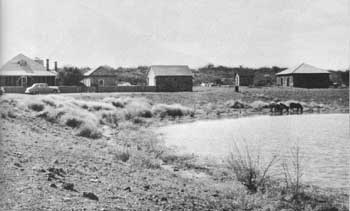






Survey of Historic Sites and Buildings
 |
SAN BERNARDINO RANCH Arizona |
 |
| ||
Ownership and Administration. Privately owned.
Significance. One of the oldest cattle ranches in Arizona, San Bernardino had its origins in Spanish colonial days. A well-known watering place on the Spanish military trail from Chihuahua to Tucson, it was visited by Juan Bautista de Anza and Father Francisco Garces. For a while it was the site of a presidio and a hacienda, whose owners may have done some ranching. Reminiscent of presidial days is the name of a mesa near the ranch—Mesa de la Avansada (Mesa of the Advance Guard).
In 1822, during a period of peace with the Apaches, Lt. Ignacio Perez applied to the Mexican Government for a large tract of land surrounding San Bernardino Springs on which to graze cattle. He bought four sitios of land, 73,240 acres, but he controlled more than 1 million acres. At the peak of his prosperity, the ranch supported 100,000 cattle, 10,000 horses, and 5,000 mules. It was a sumptuous establishment, patios and flowering gardens surrounding its spacious adobe buildings. But all too soon the Apaches resumed their attacks, and in 1831 Perez abandoned the ranch. The cattle, left untended, soon went wild. Though the Apaches preyed upon them, they multiplied and overran the vicinity. Some attacked Lt. Col. Philip St. George Cooke's wagon train while it was en route to California during the Mexican War.
 |
| Ranch buildings at San Bernardino Ranch, in the San Pedro River Valley of Arizona. John Slaughter built them in the 1880's and 1890's. |
The American phase of ranching at San Bernardino began in 1884, when John Slaughter purchased the grant. Slaughter had arrived in Arizona from Texas and then worked for 7 years as a contractor and wholesaler of beef. He subsequently purchased the ranch, built his headquarters near the old Perez hacienda, and began running his cattle on both sides of the international boundary line. He dammed the springs and built irrigation networks. About 30 families living on the ranch harvested his hay, vegetables, and fruit.
In 1886 Slaughter formed a partnership with George W. Lang, a famous trail driver who owned the Bato Pico Ranch on the Bavispe River of Sonora. The Bato Pico adjoined San Bernardino on the south, and the two partners purchased cattle in Sonora and held them on the San Bernardino until they could be shipped to California markets. They even operated a slaughterhouse in Los Angeles for much of this beef. In 1890 Slaughter bought the Bato Pico from Lang, along with all the cattle, and the partnership was dissolved. Slaughter, who also achieved fame as the sheriff of Tombstone, died in 1922; and, because he had no sons, Mrs. Slaughter sold the property.
Present Appearance. The ranch is presently owned by Marion L. Williams of Douglas, Ariz. Most of the headquarters buildings, dating from the 1880's and 1890's, are still intact and in use. These include the main ranchhouse, a stone-and-adobe cookhouse, a bunkhouse, and utility buildings. Ruins of the houses Slaughter erected for his Mexican farmers still stand at various points in the valley. Evidences of the Perez Ranch may also be seen nearby—ruined foundations and traces of adobe walls. [1]
NHL Designation: 07/19/64
 |
 |
http://www.cr.nps.gov/history/online_books/prospector-cowhand-sodbuster/siteb1.htm
Last Updated: 22-May-2005